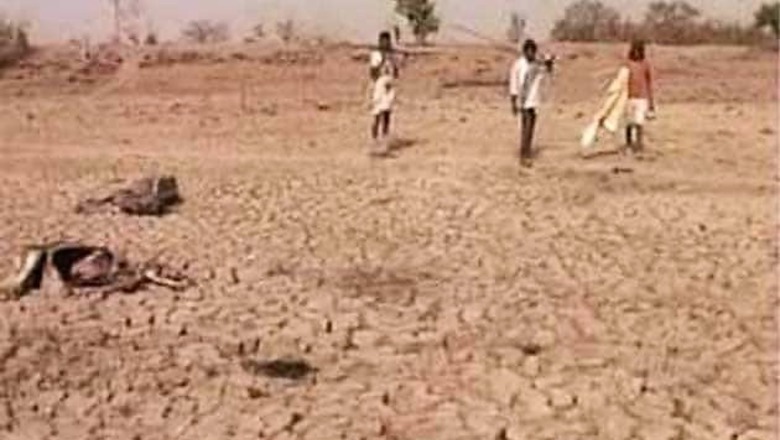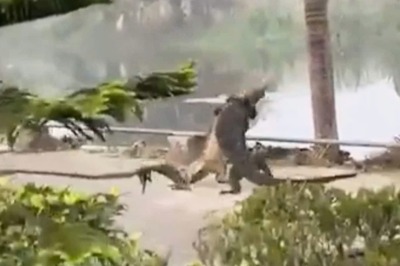
views
The usual dusty small-town India greets us as a small group of people associated with the NGO Caring Friends travel over two-and-a-half days through Aurangabad and Jalna to understand the problems in the region and what help could be given. On the face of it, people seem to be going about their normal life. Where are the signs of distress that we had read in the media? Don't girls and women in many parts of rural India carry water over long distances? Aren't water tankers a common sight in many towns and cities, including Mumbai?
The feeling that all is normal is broken the moment we see the dried up, shrivelled fields of sweet lime (mausambi) and cotton planted on thousands of acres along the way. When we stop to speak to people, the consensus is that this year's drought is worse than the one in 1972. But there is one major difference: There is no shortage of food this time around. Although we hear stories of cattle perishing and migration out of villages in search of work, fodder prices have remained remarkably stable.
However, the price of one commodity has moved up: Water, usually considered to be available freely like air. One tanker of water (8,000 litres) now costs Rs 1,200-1,500, up from Rs 300-500 last year. Increasingly the tankers have to fetch water from places further away. We hear numerous stories about how ground water is depleting fast: In Sangli, some 20,000 bore wells were dug over two months, all up to a depth of 600-1,000 feet and water was found in less than 50 bore wells; we hear about "Bore Bahadur", a person who dug 41 bore wells in an acre of land in Amravati district.
One of the most heart rending stories for me is to know that girls in a local college hostel were eating just one meal a day to save on costs because otherwise their families would have pulled them out of college. Girls are the first to be pulled out when resources are stretched and extra hands are needed to fetch water. The Chamber of Marathwada Industries & Agriculture has started giving scholarship of Rs 1,000 per month to the girls so they can eat two meals a day and continue their education.
Our first stop is village Vadkha, in Aurangabad district, where Dr Avinash Pol of Satara has been helping people to build check dams. Dr Pol is a dental surgeon, but for the people in Satara district he may well be a superhero. He has rejuvenated lakes and ponds, got government schemes sanctioned and implemented, something which we all know is near impossible.
Vadkha is just another dot on the map, less than an hour from Aurangabad. Right next to the village primary school is the only well in the village where women and young girls are drawing water. Vadkha is a well-to-do village by all accounts; every day two tankers come and pour water into the well. The tankers cannot wait since they are in great demand and more trips mean more profits.
A special mid-day meal is being prepared in the primary school, as a farewell to the Class VII students who will now head out to the nearest secondary school. The men and teenage boys languidly mill around the village square. I am left wondering why the young girls are not in the school, and are drawing water instead. Is this India's demographic dividend?
The drought has been a boon for village stores where Nestle's Dairy Milk Whitener is doing brisk business, as milk supplies in the village dry up.
Consumption is booming if you go by the motorcycles and the products being sold in the shops.
The blackened trees with shrivelled fruits, some still a dark shade of orange, is the first sight that tells us all is not well. Lakshman, a young farmer from Akoladev village, has formed a co-operative of farmers with 2,500 acres of fruit and cotton cultivation. Almost 90 percent, he reckons, has been lost. We are standing in one of his farms and all the sweet lime trees are brown and dead. The earth is parched and cracked. He's paid back the Rs 8 lakh loan he took when the limes were planted; the trees have a normal fruit bearing life of 15 years, but they're all dead in five. As I stand there taking pictures on my camera, a villager accompanying us is also taking some on his camera. Both of us are Nikon users-a D80 for me and a Coolpix for him.
About 30 km from Lakshman's village is a huge man-made lake-rather, it used to be a lake, we were told. Up from the embankment, about 30-40 feet high, what we see is not a lake but a huge field of melons. The melon plants are withering away and most of the tiny melons have started rotting for want of water. Villagers have dug two wells and are laying a pipeline to the nearest well where there is a pumping station to pump water to their village. All this is being done at their own cost (about Rs 2.5 lakh plus the labour they are putting in), whereas it costs Rs 3 lakh per month to get tankers to supply water to the village (assuming per capita per day consumption of 3 litres, in the village of over 4,200 people). The government prefers to supply tankers water rather than build pipelines.



















Comments
0 comment